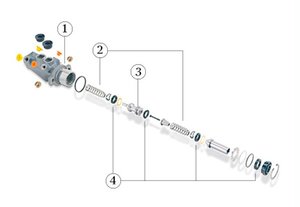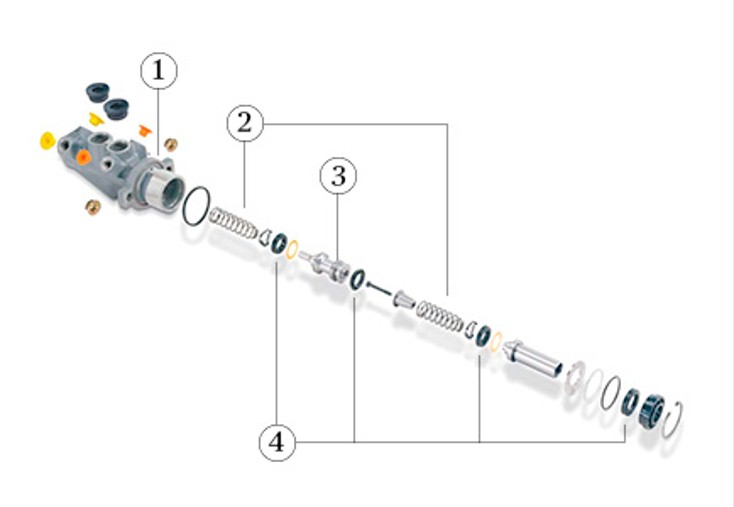Master brake cylinder
The master cylinder, also known as the master brake cylinder, converts the pressure on the brake pedal to hydraulic pressure by feeding brake fluid into the brake circuit and controlling this according to the mechanical force...
Function
The master cylinder, also known as the master brake cylinder, converts the pressure on the brake pedal to hydraulic pressure by feeding brake fluid into the brake circuit and controlling this according to the mechanical force. Master brake cylinders are used both in disc brakes and drum brakes.
Brake circuits of brake master cylinders
 Due to statutory provisions, a car must be equipped with two separate brake circuits. So-called tandem master cylinders generate the hydraulic pressure for the two separate brake circuits. In the event of one brake circuit failing, the brake pressure builds in the other brake circuit still intact.
Due to statutory provisions, a car must be equipped with two separate brake circuits. So-called tandem master cylinders generate the hydraulic pressure for the two separate brake circuits. In the event of one brake circuit failing, the brake pressure builds in the other brake circuit still intact.
When the driver presses the brake pedal, the power from his/her foot on the pedal is transmitted to the pressure piston. The piston is pushed towards the brake line.
Master cylinders in older vehicle models
In master cylinders in older vehicle models, the piston collar passes over the compensating bore, the pressure chamber is closed and braking force is generated. When the driver now releases the brake pedal, the pressure piston, supported by a spring, is returned to its original position. Brake fluid then flows into the main cylinder, so that if the pedal is pressed again immediately, the brake pressure is increased.
Master brake cylinders in newer vehicles
Newer vehicles with ESP® do not have compensating bores and replenishment ports.These components' tasks are assumed by the central valves.
When the master brake cylinder is in the neutral position, the central valve is open. The volume compensation between the brake fluid reservoir and the wheel brake is achieved via the replenishment port and the bores in the piston.
When the brake is operated, the central valve is closed, interrupting the connection between the brake fluid reservoir and the wheel brake. The pressure can now begin to build. Closing the central valve is the equivalent of the primary collar passing over the compensating bore in a master brake cylinder with such a bore.
Releasing the wheel brakes
After the brake pedal is released, pressure in the circuit falls and the wheel brakes are released. The piston returning to its neutral position can create a vacuum, which opens the central valve and therefore ensures that brake fluid is replenished. After the release procedure is complete, the neutral position is achieved and the central valve stays open.
Safety
The brakes are one of the most important safety systems of a vehicle. Unbeknown to the driver, they are applied and released hundreds if not thousands of times a day. The driver usually only brakes consciously if braking does not follow the usual procedure.
For safety reasons, only tandem master cylinders are installed today. If however, one brake circuit of the tandem master cylinder fails, the pedal travel increases when braking. If this happens, a visit to a garage is absolutely necessary.
Depreciation
Master brake cylinders from well-known suppliers feature the use of premium materials, which afford reliable protection against corrosion, thereby ensuring that the master cylinder has a long service life and functions optimally.
Regularly checking and replacing the brake fluid is vital for the shelf life of the entire brake system. In addition, the ventilation hole on the top-up reservoir should be kept clean and open. This hole should be closed before cleaning the engine, as water may penetrate otherwise.














